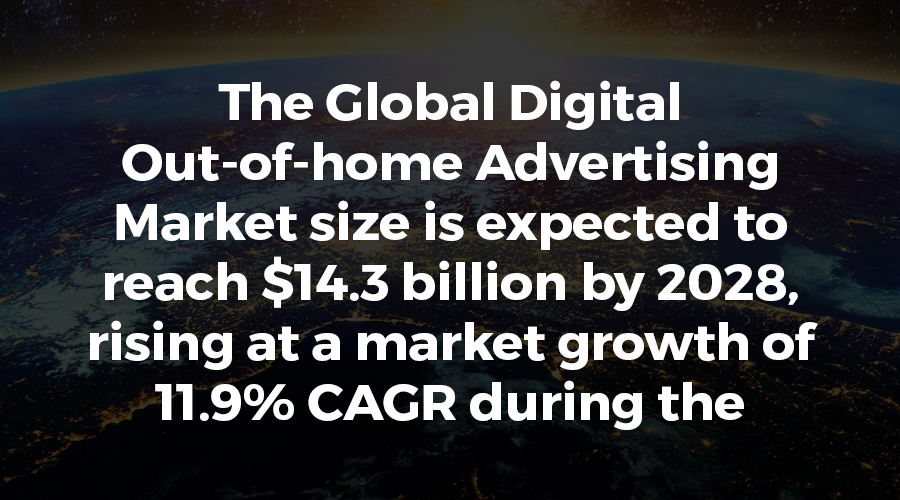The Global Digital Out-of-home Advertising Market size is expected to reach $14.3 billion by 2028, rising at a market growth of 11.9% CAGR during the forecast period


Digital out-of-home (DOOH) advertising is a type of outdoor advertising that combines both digital and traditional out-of-home components. These digital adverts are displayed on publicly accessible real estate in various locales.
New York, July 04, 2022 (GLOBE NEWSWIRE) — Reportlinker.com announces the release of the report “Global Digital Out-of-home Advertising Market Size, Share & Industry Trends Analysis Report By Format, By Vertical, By Regional Outlook and Forecast, 2022 – 2028” – https://www.reportlinker.com/p06289235/?utm_source=GNW
Since data is displayed on digital screens in real-time, digital out-of-home commercials give unique and original material, which becomes more interactive and creative. This feature improves the visibility of digital displays. As the desire for interactive commercials among consumers grows, so does the adoption of digital out-of-home advertising, propelling the market forward.
Developed countries continue to dominate the industry, with the highest screen penetration, while demand in underdeveloped countries is growing. The rise in urban population and economic development are contributing to the growing demand. Because of the expansion in the urban population, there has been an increase in spending power, and as a result, firms are heavily targeting those locations to increase their penetration. The Asia-Pacific region has the largest middle-class population, and the region’s economic expansion is expected to stimulate advertising spending.
Furthermore, the money spent on advertising has been steadily increasing. For example, the United States of America led the list, followed by China and Japan. When it comes to ROI per screen, the United States of America has been ranked first. Advertisers are also developing more imaginative and interactive street furniture, which allows them to engage their audiences while simultaneously collecting data about them.
Brands can utilize DOOH to effectively advertise products even if they are not equally available everywhere with the right technological partner. For example, if a company wants to launch a new frozen pizza line – initially in a few cities, then nationally – it could utilize DOOH to target each market individually. One might need a campaign stating that the pizzas are currently available, while another might need to emphasize that the new range will be available shortly. Technology allows for fast adjustments based on different locales, DMAs, zip codes, or even audiences, ensuring that overall messages are received locally. A planning process that used to take weeks may now be completed in minutes, with success tracked using indicators like attributable sales and foot traffic.
COVID-19 Impact
The COVID-19 outbreak has had a severe impact on the digital out-of-home advertising industry. In reaction to the pandemic and the serious health threat posed by the virus, governments around the world instituted quarantines, lockdowns, travel bans and restrictions, and work-from-home directives to try to contain the virus. These measures have had a severe impact on the digital out-of-home advertising industry’s workforce and operations, as well as the behaviors of advertising clients and consumers and the operations of raw material suppliers. Various markets have been negatively impacted by the COVID-19 pandemic as a result of the impact on companies’ operating profits.
Market Growth Factors
Widespread Adoption of Displays and Popularity of the Digital Medium
The increased use of commercial displays in the advertising industry is expected to accelerate the growth of the digital-out-of-home market. The advent of relatively low-cost digital displays can be credited for the growth. The industry is expected to benefit from increased usage of virtual reality and augmented reality, cloud-based platforms, and the growing demand for IoT. In addition, combining DOOH with VR and AR allows businesses to increase the engagement and reach of their initiatives. Cloud-based solutions offer benefits such as flexibility, connection, and improved content management, which are fueling industry demand.
Combination of DOOH and User Generated Content (USG)
On DOOH, user-generated material leaves a long-lasting impression on the consumer. It provides the kind of relatability that consumers look for in popular advertising. A corporation can efficiently show adverts with the goal of increasing recognition, exposure, and engagement. Placing DOOH in areas where passersby have more idle time, such as bus stops, train stations, or travel mediums, can increase the number of people who see the advertisement. Almost every brand employs expert model airbrushing. The consumer would be enticed to interact more if they saw a peer as a brand’s advocate. Not only that, but it will be relatable and memorable to them.
Market Restraining Factors
DOOH is Expensive to Implement
Along the highways, there are numerous billboards. Drivers are more focused on the road than on advertisements on the side of the road. Many billboards are only seen for a second or two at most. Thus, the biggest problem with digital out-of-home advertising formats is their fleeting nature. Companies have to pay large sums of money for their advertisement to be looked at for only seconds on average. As a result, the cost of advertising per exposure may be higher than with other approaches. This factor makes it somewhat unfeasible for small and medium-sized enterprises. Billboards cost more per panel than other types of digital out-of-home advertising, such as shopping center 6-sheets or post office screens.
Source:

